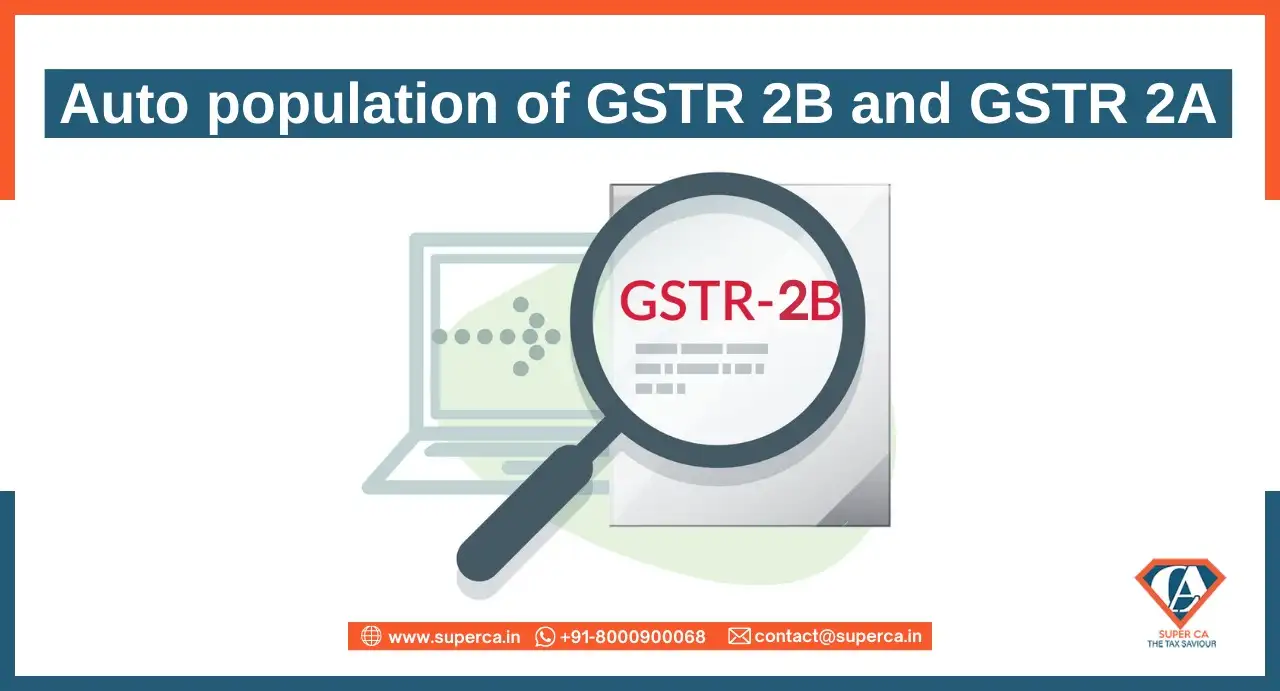Difference between Auto population of GSTR 2B and GSTR 2A
- Posted By SuperCA
- On 24 September

About
GST return is a document that contains all the details of sales, purchases, tax collected on sales and tax paid on purchases. There are a number of GST Returns which have their specific forms under the GST regime and each form has a different purpose. All the Registered Dealers are required to file GST Returns irrespective of the type of business or turnover or profitability during the return filing period. In this blog we’ll confine our approach to GSTR 2A and 2B comparison and difference.
Two types of auto-populated returns/statements were introduced under the GST regime namely-
Form GSTR - 2A (Read-only return)
GSTR 2A is read only document for the recipient, to verify the details uploaded by the seller in GSTR-1. It contains the details of all inward supplies of goods and services i.e., purchases made from GST registered suppliers during a particular tax period.
Form GSTR-2B– Auto drafted ITC statement
GSTR-2B is an auto-drafted Input Tax Credit statement, recently introduced by GSTN to simplify Input Tax Credit Claim for taxpayers. It is a fixed statement and will be generated after 12th of every month for every recipient on the basis of the information furnished by their suppliers in their respective GSTR-1, GSTR 5 and GSTR 6.
It’s interesting to note that both the above mentioned statement reflects details of inward supplies as well as details of an ITC. Since both the statements cover the same details, it is important to understand the distinction between the same.
GSTR-2A vs GSTR-2B
Both the Form GSTR-2A and GSTR-2B are different in various ways, even though both reflect similar details. Distinction between both the forms is summarized below-
Type or Nature
GSTR-2A is represents a form of a dynamic statement as it changes from day to day, as and when a supplier reports the documents.
On the other hand, Form GSTR-2B is a form of a static statement i.e the GSTR-2B for one month, cannot change based on actions of the supplier taken later on.
Reflection of details
The details of the inward supplies will be reflected in the statement on a real-time basis in case of Form GSTR 2A. i.e the details will be updated as and when the details of outward supplies is furnished by the supplier either in Form GSTR-1 or via using Invoice Furnishing Facility.
On the other side, in the case of Form GSTR-2B, the details of inward supplies will be reflected in a static manner i.e it will reflect the details of outward supplies reflected by the supplier between two due dates of either Form GSTR-1 or Invoice Furnishing Facility.
Advisory on ITC claims
Form GSTR-2A does not consist of information/advisory on the action a registered buyer needs to take Whereas, Form GSTR-2B briefly consist of an advisory against each section on whether the ITC is eligible, ineligible or reversal, for the taxpayer to take action accordingly in his GSTR-3B
Source of Data
Form GSTR-2A compiles data on the basis of returns filed by the supplier in Form GSTR-1 or IFF; Form GSTR-5; Form GSTR-6; Form GSTR-7 and Form GSTR-8.
Whereas, Form GSTR-2B compiles data from Form GSTR-1 or IFF; Form GSTR-5 and Form GSTR-6 filed by the supplier.
Reconciliation of ITC
Rule 36(4) of the CGST Rules, 2017 clearly mentions that the registered person is eligible to avail a maximum up to 5% of an ITC in respect of invoices or debit notes which are not reflected by supplier either in Form GSTR-1 or IFF.
Since GSTR-2B is static and hence the same can be taken as a base as will give the upper limit of ITC that can be claimed in the respective month, that will consist of invoices of both current month and also late filed invoices of previous months. Given that it is a fixed statement and available only on 12th of the subsequent month, the initial checking and matching of data can be continued using GSTR 2A.
Notably, GSTR 2B in the current scenario includes data from GSTR 2A and soon will include invoices related to import transactions and be a richer and comprehensive source for ITC computation. The reconciliation based on GSTR 2A and comparative reports based on GSTR 2B is definitely an alternative way which taxpayers can explore for maximising their ITC claim





